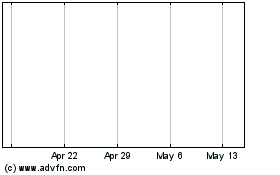Westfield Annual Profit Falls
February 22 2017 - 5:42PM
Dow Jones News
By Rebecca Thurlow
SYDNEY--Westfield Corp. (WFD.AU), one of the world's biggest
owners of shopping malls, said annual net profit fell 41% as
property revenue slipped following US$1.7 billion in asset sales
the year before, and it was squeezed by the depreciation of the
British pound.
Westfield, which has interests in 35 shopping centers in the
U.S. and the U.K. including the World Trade Center mall in New
York, on Thursday reported a net profit of US$1.37 billion for the
year through December against a year-earlier profit of US$2.32
billion.
Operational performance over the year was solid, and more than
US$1 billlion in revaluation gains were achieved thanks to
completed developments, said Peter Lowy and Steven Lowy, the
company's joint chief executive officers.
The company recorded a more than US$1.1 billion deferred tax
credit for 2015, including a change in applicable rates and for the
revaluation and depreciation of property investments.
Sydney-based Westfield, which has a market value of 18.7 billion
Australian dollars (US$14.4 billion), spun off its Australian and
New Zealand malls into a separate company called Scentre Group
(SCG.AU) in a deal that was completed in mid-2014.
After the demerger, it began reducing its holdings of regional
assets and increasing its investment in better performing flagship
stores in major centers such as London and New York. In 2015, it
sold six assets deemed non-core for US$1.3 billion.
The company said it will pay a final dividend of 12.55 US cents
a security, steady on a year ago, for a full-year payout of 25.1
cents. Westfield forecast total distributions of 25.5 cents a
security in 2017.
Funds from operations--a smoothed measure of operating cash flow
that excludes depreciation, amortization and gains on asset
sales--rose by 3.8%, on a constant-currency basis, to 33.7 cents a
share. The result was at the lower end of guidance released by
Westfield in September. It forecast funds from operations for the
coming year would be between 33.8 and 34 cents.
Revenue fell by 7.3% to US$1.8 billion from US$1.94 billion in
2015.
Several large retailers in the U.S. have closed stores in recent
months including Macy's Inc. and Sears.
In August, Westfield officially opened its US$1.5 billion World
Trade Center mall in New York, a milestone in the company's
strategy to create and operate flagship assets in leading markets.
Westfield expects the Lower Manhattan mall to be the most
productive shopping center in its portfolio and generate up to US$1
billion in annual sales. It expects almost 100 million customer
visits a year to the mall, taking its total customer visits each
year to half a billion, a 25% increase.
The company's US$9.5 billion development pipeline includes
US$3.7 billion in projects under construction, such as Century City
in Los Angeles and UTC in San Diego, as well as future projects
including Valley Fair in San Jose California and Westfield Milan in
Italy. The Milan project, the company's first development in
continental Europe, is expected to launch in early 2018 and
complete in 2020.
In May, Westfield decided to keep its primary stock market
listing in Australia after reviewing the merits of moving it to the
U.S. where most of its properties are located. Chairman Frank Lowy
said that since the spinoff of Westfield's Australian shopping
centers into a separately listed company in 2014, the stock has
done very well relative to its global peers. This trading
performance, along with the complexity and disruption associated
with moving the listing, led the board to conclude that the
benefits of such a move were currently marginal.
Westfield said specialty sales per square meter rose 2.2% for
the year, with the pace of growth in its flagship operations
outpacing its regional malls. Unlike a department store, a
specialty outlet is one that focuses on a particular niche, such as
clothes or electronics.
Write to Rebecca Thurlow at rebecca.thurlow@wsj.com
(END) Dow Jones Newswires
February 22, 2017 17:27 ET (22:27 GMT)
Copyright (c) 2017 Dow Jones & Company, Inc.
Westfieldc Stapled (ASX:WFD)
Historical Stock Chart
From Mar 2024 to Apr 2024

Westfieldc Stapled (ASX:WFD)
Historical Stock Chart
From Apr 2023 to Apr 2024
